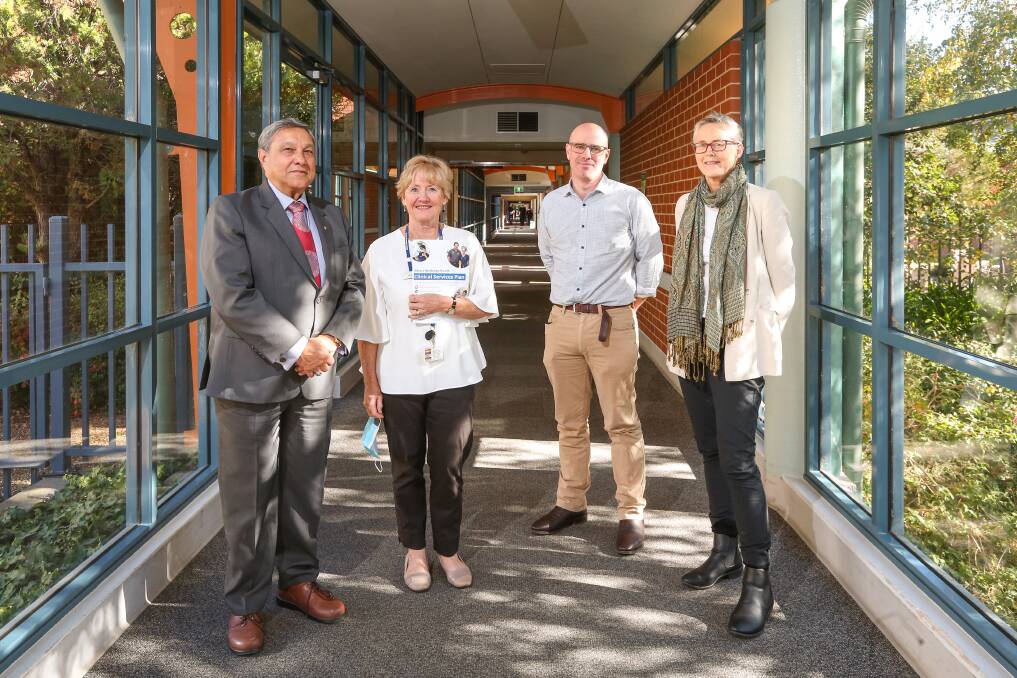
Albury Wodonga Health will pursue a single-site hospital for the delivery of emergency care, its clinical services plan has revealed.
Subscribe now for unlimited access.
$0/
(min cost $0)
or signup to continue reading
The plan is an assessment of current operations and projected future demand, and recommends the consolidation of acute and sub-acute care to a single site.
It identified "splitting acute and sub-acute service delivery across two campuses creates significant risks to patient safety and reduces AWH's ability to deliver safe and high-quality care".
AWH Chief executive Michael Kalimnios said the CSP was the 'what' and 'why' of the service's future, and a master plan would be the 'how' - identifying where the site for emergency care would be.
"The big issue that's been highlighted in the clinical services plan is that we need to be moving to a single site for acute and sub-acute services," he said.
"This isn't saying that we need to go to a greenfield site, this is just really talking about a single site.
"Part of what the master plan will do, which is our next phase, is work through whether the best option is a greenfield site or a brownfield site.
"The document really focused on expanding current services.
"There's certainly capacity issues that we need to address to make sure we can deliver services closer to home, that the community should expect to access."
Director of emergency and critical care services David Clancy called the CSP a "watershed moment".
"This is a key document for developing what we need for the future," he said.
"Where this is an essential moment is that now we have the clinicians and the hospital walking side by side with what we actually need to deliver.
"It has been an exhaustive process ... and it was continued until clinicians were satisfied that we'd had enough feedback on the document."
Dr Clancy said coming home to the region, it was clear from a distance "we were lacking resources" in comparison to other regional health services.
"I've had family members that have had to fly out for services that I know should be able to be delivered here," he said.
"We do carry risk with how we operate. We duplicate resources across two campuses, and then we isolate other resources.
IN OTHER NEWS:
"Where we try to keep our patients safe, is through the effort and the energy of our staff.
"So while we carry risk with duplication, while we carry a risk with isolation, it is our nurses, our doctors, our radiographers, (and) our transport staff, that carry the load to ensure that our patients remain safe.
"We are starting to feel the strain."
The need for AWH to undergo significant service expansion, with increased bed stock and surgical theatres, aligns with creating a workplace plan.
The plan proposes for AWH to be a regional leader, provide onsite 24/7 pathology and imaging services, collocate maternity and neonatal services with acute services, improve self-sufficiency for surgical capacity and more.
Consultation for a masterplan was done in 2018 by the Victorian Health and Human Services Building Authority, but Mr Kalimnios said it was department-led and didn't have "clinician buy-in".
Deputy chief executive Janet Chapman, who was part of that concept planning, said it was more limited and done without a new CSP.
"The significant change here is this is recommending a single site," she said.
"We've got really strong evidence now to say, 'This is what's going to happen to our population', 'This is how much activity we could and should be providing in the service'.
"And it (the CSP) does call out the issue that we don't have enough enough beds, we don't have enough theatres.
"The new ED will be finished in 2022."
Dr Clancy conceded AWH would quickly outgrow its $30 million ED expansion, but it was crucial to have a clear plan for "what lies behind" emergency.
"Now we will have all the stakeholders moving forward to shake the tree to make sure what we have next is not piecemeal funding," he said.
AWH board chair Matt Burke said governments would be lobbied for funding to "do it once and do it right".
Key points of the plan will be made available on the AWH website.
It does not cover mental or allied health, which will receive their own plans.


